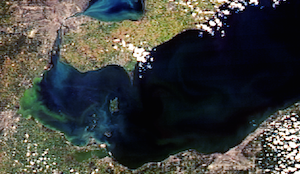By Karen Schaefer
A team of U.S. and Canadian scientists working under a bi-national treaty are proposing new limits on phosphorus pollution to Lake Erie from farm fields and sewage treatment plants. Independent producer Karen Schaefer reports:

Karen Schaefer is an Ohio freelance journalist and independent radio producer.
SCHAEFER: The new limits would reduce phosphorus run-off from farms and sewers in six states and the province of Ontario to all parts of Lake Erie and its tributaries by 40-percent over current levels. Ohio State University’s Stone Lab director emeritus Jeff Reutter co-chaired the research team. He says the new limits should go a long way to reducing harmful algae blooms in Lake Erie, like the one that shut down Toledo’s drinking water last year.
REUTTER: The 40-percent reduction is going to produce a bloom that looked like the blooms we had in 2012. That’s a relatively small bloom. It’ll produce a bloom like that, or less, nine years out of ten.

Western Lake Erie algal bloom in 2012. Image: NOAA
SCHAEFER: Reutter says states could decide on higher reductions in some rivers like the Maumee. If adopted next year, the new limits would become mandatory under the Great Lake Water Quality Agreement, beginning in 2018. For Great Lakes Echo, I’m Karen Schaefer.
Support for Karen Schaefer’s public radio series is provided by the Ohio Sea Grant College Program at Ohio State University.